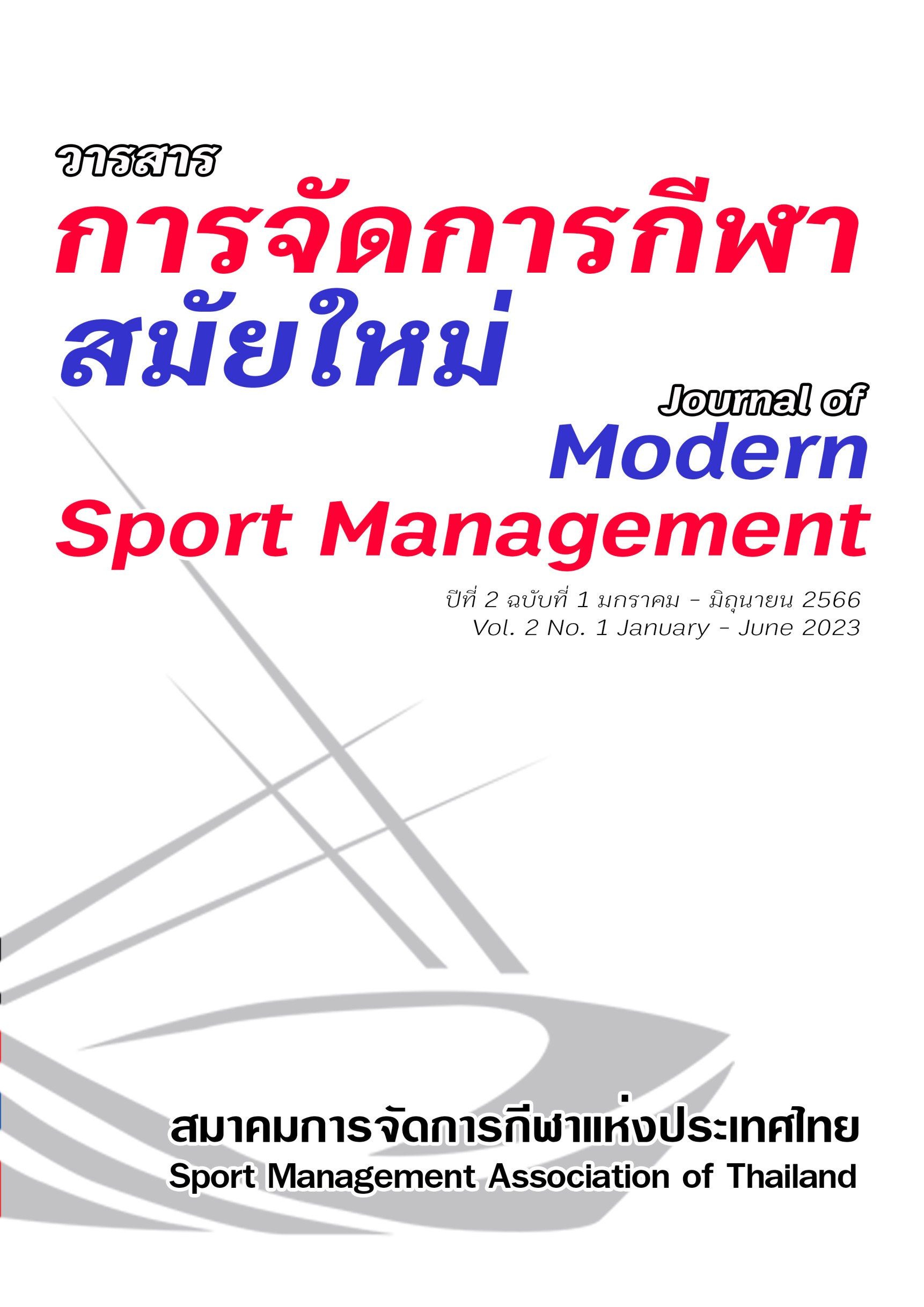ความแตกต่างด้านลักษณะทางประชากรศาสตร์ที่มีผลต่อการรับรู้คุณภาพการบริการกีฬามวยไทยอาชีพ: กรณีศึกษาการแข่งขันกีฬามวยไทยอาชีพ รายการ แม็กซ์มวยไทย
Main Article Content
บทคัดย่อ
จากสถานการณ์การแพร่ระบาดของโรคติดเชื้อไวรัสโคโรนา 2019 นำไปสู่การรับรู้คุณภาพการบริการ
ของผู้เข้าชมการแข่งขันกีฬามวยไทยอาชีพที่แตกต่างจากที่ผ่านมา บทความวิจัยนี้จึงมีวัตถุประสงค์เพื่อศึกษา
การรับรู้คุณภาพการบริการกีฬามวยไทยอาชีพ และเปรียบเทียบการรับรู้คุณภาพการบริการจำแนกตามเพศ อายุ รายได้ ระดับการศึกษา และประสบการณ์ โดยใช้แบบสอบถามที่มีค่าความตรงเท่ากับ 0.745 และค่าความเที่ยง เท่ากับ 0.914 เก็บข้อมูลจากผู้ชมการแข่งขันกีฬามวยไทยอาชีพ รายการ แม็กซ์มวยไทย จำนวน 400 คน
ณ สนามแข่งขัน แม็กซ์มวยไทย ระหว่างเดือนสิงหาคม ถึง เดือนธันวาคม 2563 ใช้การวิเคราะห์ข้อมูลเชิงอนุมาน ได้แก่ t-test และ F-test เพื่อเปรียบเทียบการรับรู้คุณภาพการบริการของผู้ชมการแข่งขันที่มีลักษณะทางประชากรศาสตร์แตกต่างกัน
ผลการวิจัยพบว่าการรับรู้คุณภาพการบริการกีฬามวยไทยอาชีพโดยรวมอยู่ในระดับมากที่สุด (=4.38) โดยด้านการรับรู้คุณภาพที่มีค่าเฉลี่ยมากที่สุด ได้แก่ 1) ด้านผลลัพธ์ (
=4.43) 2) ด้านสภาพแวดล้อมทางกายภาพ (
=4.40) 3) ด้านปฏิสัมพันธ์ (
=4.39) และ 4) ด้านการแข่งขัน (
=4.30) นอกจากนี้ผู้ชมการแข่งขันกีฬา
มวยไทยอาชีพที่มีประสบการณ์แตกต่างกันมีการรับรู้คุณภาพการบริการด้านปฏิสัมพันธ์ (t=2.877) และ
ด้านผลลัพธ์ (t=4.429) แตกต่างกันอย่างมีนัยสำคัญทางสถิติที่ระดับ .05 แต่ในทางตรงกันข้ามผู้ชมการแข่งขันกีฬา
มวยไทยอาชีพที่มีเพศ อายุ รายได้ และระดับการศึกษาแตกต่างกันมีการรับรู้คุณภาพการบริการไม่แตกต่างกันอย่างมีนัยสำคัญทางสถิติที่ระดับ .05 ดังนั้นผู้ประกอบการหรือผู้จัดการสนามแข่งขันกีฬามวยไทยอาชีพสามารถพิจารณานำข้อมูลจากการวิจัยนี้ไปตัดสินใจเพื่อให้บริการผู้ชมการแข่งขันอย่างเฉพาะเจาะจงตามกลุ่มผู้ชม
Article Details

อนุญาตภายใต้เงื่อนไข Creative Commons Attribution-NonCommercial-NoDerivatives 4.0 International License.
เอกสารอ้างอิง
Brady, M. K., & Cronin Jr, J. J. (2001). Some new thoughts on conceptualizing perceived service quality: A hierarchical approach. Journal of marketing, 65(3), 34 - 49.
Byon, K., Zhang J., & Baker T. (2013). Impact of core and peripheral service quality on consumption behavior of professional team sport spectators as mediated by perceived value. European Sport Management Quarterly, 13(2), 1 - 30.
Chen, X., Yim, B. H., Tuo, Z., Zhou, L., Liu, T., & Zhang, J. J. (2021). “One event, one city”: Promoting the loyalty of marathon runners to a host city by improving event service quality. Sustainability, 13(7), 3795 - 3808
Ehrenberg, A. (2003). Repetitive advertising and the consumer. Journal of Advertising Research, 40(6), 39 - 48.
Fischer, A., & Frewer, L. (2009). Consumer familiarity with foods and the perception of risks and benefits. Food Quality and Preference, 20(8), 576 - 585.
Huang, C. H., Liu, W. T., Chuang, C. L., & Huang, Y. H. (2018). The service quality and community attribute effect impacts on satisfaction for marathon event. International Journal of Economics and Business Administration, 4(3), 105 - 109.
Jin, N. P., Lee, H., & Lee, S. (2012). Event quality, perceived value, destination image, and behavioral intention of sports events: The case of the IAAF World Championship, Daegu, 2011. Asia Pacific Journal of Tourism Research, 18(8), 1 - 16.
Kanlaya Vanichbuncha. (2005). Statistics for research. Bangkok: Department of Statistics, Faculty of Commerce and Accountancy, Chulalongkorn University.
Ko, Y. J., & Pastore, D. L. (2005). A hierarchial model of service quality for the recreational sport industry. Sport Marketing Quarterly, 14(2), 84 - 97.
Leckie, C., Nyadzayo, M., & Johnson, L. (2017). Promoting brand engagement behaviors and loyalty through perceived service value and innovativeness. Journal of Services Marketing, 32(2), 70 - 82.
Nurcahyo, R., Fitriyani, A., & Hudda, I. N. (2017). The influence of facility and service quality towards customer satisfaction and its impact on customer loyalty in Borobudur Hotel in Jakarta. Binus Business Review, 8(1), 23 - 29.
Patcharamon Rucksapoldech & Anupong Taesillapasathit (2016). A Muay Thai business management model in Thailand, Veridian E-Journal,Silpakorn University, 10(1), 1255 - 1269.
Peter, P. J., & Olson, J. C. (1999). Consumer behavior and marketing strategy. Boston: McGraw-Hill.
Riel, A., Mortanges, C., & Streukens, S. (2005). Marketing antecedents of industrial brand equity:
An empirical investigation in specialty chemicals. Industrial Marketing Management, 34(8),
- 847.
Saha, G., & Theingi, T. (2009). Service quality, satisfaction, and behavioural intentions: A study of low-cost airline carriers in Thailand. Journal of Service Theory and Practice, 19(3),
- 372.
Theodorakis, N. D., Kaplanidou, K., & Karabaxoglou, I. (2015). Effect of event service quality and satisfaction on happiness among runners of a recurring sport event. Leisure Sciences, 37(1), 87 - 107.
Verbeke, W., Dietz, B., & Verwaal, E. (2011). Drivers of sales performance: A contemporary
meta-analysis. Have salespeople become knowledge brokers? Journal of the Academy of marketing Science, 39(3), 407 - 428.
Xiao, Y., Ren, X., Zhang, P., & Ketlhoafetse, A. (2019). The effect of service quality on foreign participants’ satisfaction and behavioral intention with the 2016 Shanghai International Marathon. International Journal of Sports Marketing and Sponsorship, 21(1), 91 - 105
Zabkar, V., Brencic, M. M. & Dmitrovic, T. (2010). Modelling perceived quality, visitor satisfaction and behavioral intention at the destination level. Tourism Management, 31(4), 537 - 546.


